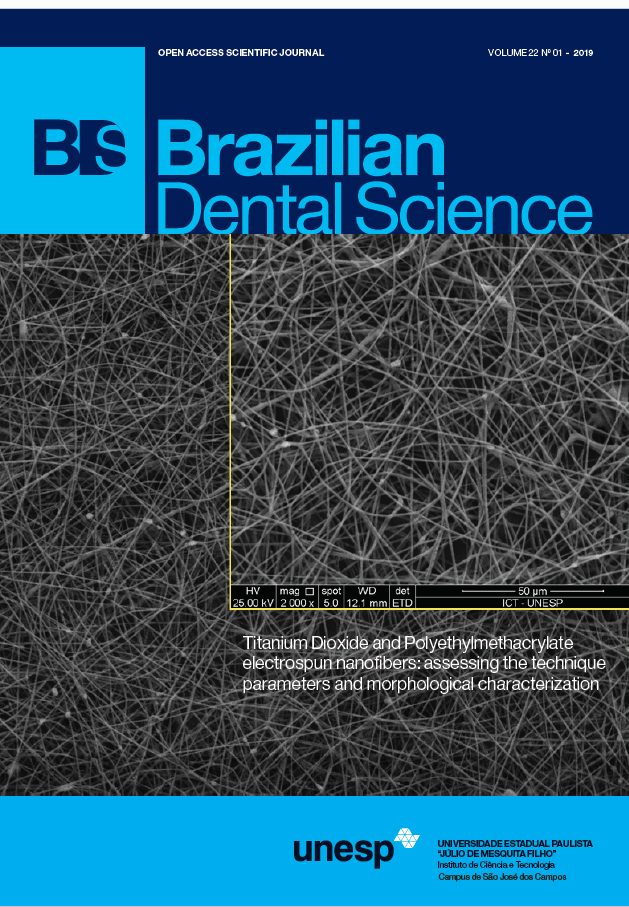Antimicrobial effect of methylene blue formulations with oxygen carrier at different pHs: preliminary study
DOI:
https://doi.org/10.14295/bds.2019.v22i1.1635Resumo
Objective: Evaluate methylene blue (MB) formulations containing oxygen carrier at different pHs in antimicrobial photodynamic therapy (aPDT). Material and Methods: Biofilms of Pseudomonas aeruginosa PA01 formed over acrylics specimens during five days were treated with aPDT using different formulations: MB/pH 7.4; MB/pH 5.6; MB/carrier pH 7.4; MB/carrier pH 5.6. Biofilms not exposed to treatment were used as a control. Blind examiner for the experimental groups performed the counting of colonies per ml suspension (CFU/ml). Two-way ANOVA was used to determine the effect of factors solvent (carrier vs water) and pH (7.4 vs 5.6). One-way ANOVA and post-hoc Tukey’s test was used to evaluate differences among the five groups (control; MB/carrier pH 7.4; MB pH 7.4; MB/carrier pH 5.6; MB pH 5.6). The Statistics 8.0 software was used (P<0.05). Results: All of photodynamic therapy groups showed significant reduction in P. aeruginosa compared to the control group. The solvent factor was not significant (P=0.18), while the pH factor presented statistical significance (P=0.01). When the carrier was used, MB formulation at pH 7.4 presented a statistically greater reduction of P. aeruginosa than the formulation with pH 5.6. Conclusion: The PDT using methylene blue formulations with oxygen carrier demonstrated potential for the treatment of localized infections by P. aeruginosa. MB formulations with oxygen carrier and pH 7.4 resulted in higher antimicrobial effect and should be considered for future studies with multispecies biofilms.
Keywords
Antimicrobial photodynamic therapy; biofilm; laser; Pseudomonas aeruginosa.
Downloads
Downloads
Arquivos adicionais
Publicado
Como Citar
Edição
Seção
Licença
TRANSFERÊNCIA DE DIREITOS AUTORAIS E DECLARAÇÃO DE RESPONSABILIDADE
Toda a propriedade de direitos autorais do artigo "____________________________________________________________________" é transferido do autor(es) para a CIÊNCIA ODONTOLÓGICA BRASILEIRA, no caso do trabalho ser publicado. O artigo não foi publicado em outro lugar e não foi submetido simultaneamente para publicação em outra revista.
Vimos por meio deste, atestar que trabalho é original e não apresenta dados manipulados, fraude ou plágio. Fizemos contribuição científica significativa para o estudo e estamos cientes dos dados apresentados e de acordo com a versão final do artigo. Assumimos total responsabilidade pelos aspectos éticos do estudo.
Este texto deve ser impresso e assinado por todos os autores. A versão digitalizada deverá ser apresentada como arquivo suplementar durante o processo de submissão.




























